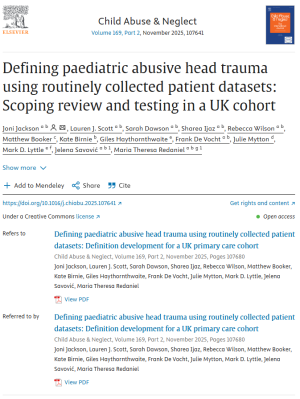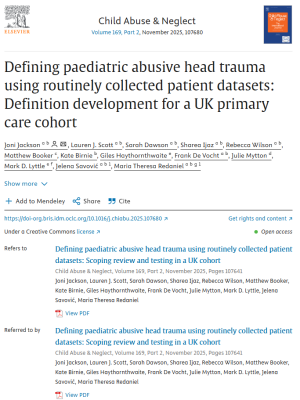New research aims to better predict and prevent head injuries in children
9 October 2025
Head injuries are one of the most common reasons children are brought to hospital, yet predicting which children are most at risk – and ensuring cases are properly identified – remains a major challenge.
Every year, around 1.4 million people attend hospital in England and Wales with a head injury. Almost half are children under 15. Even mild head injuries, often called concussions, can have lasting effects on children’s health, education and social lives. Some go on to develop post-concussion syndrome, a condition that can affect physical and emotional wellbeing long after the initial injury.
The most serious head injuries in very young children are often caused intentionally, through abusive head trauma. This can occur when a baby is shaken or struck. This is the leading cause of serious injury in babies under 6 months. But abusive head trauma is often under-reported and difficult to track in routine health data, particularly when children are not admitted to hospital.
A team of ARC West researchers has been working to address this gap.
In one study, they reviewed international research to see how abusive head trauma has been defined in electronic health records. They found 40 studies, most of which relied on hospital coding systems from outside the UK, and none that could be easily applied to British primary care data.
When they tested these existing definitions in a large UK cohort of infants, estimates of abusive head trauma varied widely, depending on how broad or restrictive the definition was. Estimates ranged from 9 to 49 cases per 100,000 ‘person-years’, which means how many cases occurred for every 100,000 individuals observed for a year.
The findings highlight the need for a standardised, UK-specific approach.
In a follow-up study, the team worked with clinical experts to develop new definitions tailored to UK health records, incorporating data from GPs, hospitals, emergency departments and diagnostic imaging. These new definitions identified more cases of abusive head trauma than existing international coding systems, suggesting that earlier estimates may have under-estimated the true scale of the problem.
The researchers caution, however, that no system is perfect: some cases may still be missed if children do not present to healthcare, while broader definitions may capture false positives.
Together, these projects are part of a wider programme aimed at predicting which babies are at greatest risk of abusive head trauma, which children are most likely to experience concussion and which may go on to develop long-term complications. The goal is to improve prevention, early detection and care, ultimately reducing head injuries in children.
Paper

Defining paediatric abusive head trauma using routinely collected patient datasets: Scoping review and testing in a UK cohort
Download the paperAdditional papers
